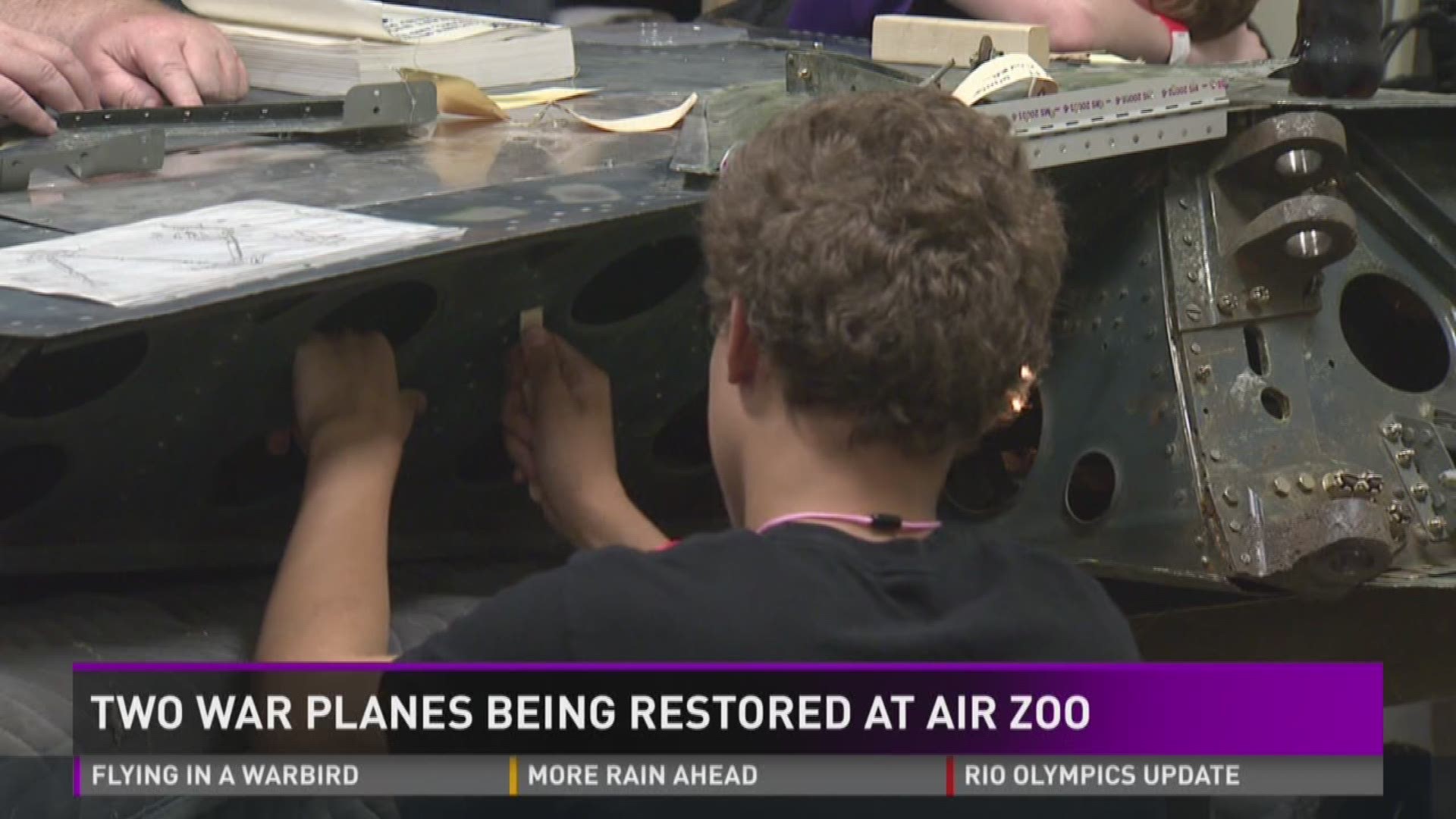PORTAGE, Mich. (WZZM) -- For the past six decades, both of them rested at the bottom of Lake Michigan. Today, they've both been raised to the surface and are in the process of being restored at the Air Zoo in Portage, Michigan.
Two World War II planes - an "FM-2 Wildcat" and a "Douglas SBD Dauntless" dive bomber - have both been recovered from the depths of Lake Michigan within the past 7 years.
"We're really excited here at the Air Zoo to have really expanded our restoration function over the past several years," said Troy Thrash, President & CEO of the Air Zoo. "That's aided us in getting these aircraft here."
The FM-2 Wildcat aircraft crashed in Lake Michigan, just off the Chicago coastline, in 1944. It had been resting in the deep for 68 years, until its remains were brought up to the surface in 2012.
The SBD Dauntless dive bomber suffered a similar fate as the Wildcat. It lay on the lake bottom for 65 years.
A&T Recovery, which is based in Chicago, located the two aircraft with side-scan sonar. These two planes are among 120 that A&T Recovery have located.
How these two planes ended up at the bottom of Lake Michigan is quite fascinating.
"During World War II, there were two passenger cruise ships that had their decks leveled to basically create a simulated aircraft carrier," Thrash explained. "There was a need for American pilots to be trained to take off and land on aircraft carriers before they could be cleared to go fly in the Pacific or in Europe.
"Over 15,000 pilots were trained over a period of several years, practicing takeoffs and landings on reconstructed surfaces of these cruise ships.
"Many of the planes, including the Wildcat and the SBD, missed their marks, and crashed over the side of the cruise ships into the lake.
"Of the 15,000 pilots who trained, only 120 planes were lost, and 40 of those planes have been brought up from the bottom of the lake so far."
In order for the Air Zoo to obtain these two artifacts, it needed permission from the United States Navy.
"The first plane that became available was the Wildcat in 2013, so we drafted a proposal to the U.S. Navy and to the National Naval Aviation Museum," said Thrash. "In the proposal, we said that we will do a really great job in restoring these planes because we had done similar work on aircraft for the Navy in the past.
"We also explained in the proposal that we weren't going to do it like we've done before, like many restoration centers do, which is putting it in a black box where nobody can see it for five or six years, and then it comes out and magically appears like brand new again.
"We said we were going to do the restoration on the exhibit floor, allowing everyone who visits the Air Zoo to be able to see it; to be able to experience it; to be able to talk to our restoration volunteers and learn all about the history of the aircraft and the restoration process."
The U.S. Navy and the National Naval Aviation Museum both liked the idea put forth by the Air Zoo in the proposal, and decided to entrust these two historical artifacts to be restored in Portage.
The Air Zoo received the Wildcat in 2013, and began restoring it in 2014. Thrash says the project should take a total of five years to complete. Once it's restored, the Air Zoo plans to bring the Wildcat to Navy Pier in Chicago where it will be placed on display for 10 million people to view every year.
"The Douglas SBD bomber was brought to the Air Zoo in July of this year," said Thrash. "Our group of restoration experts are currently exploring the best plan of attack, and we hope to begin restoring it in October of this year."
The SBD bomber has an interesting back story, in that it served for a time in Hawaii at Pearl Harbor shortly after the attack on December 7, 1942. When the restoration of the SBD bomber, Thrash says the Air Zoo plans to return it back to Pearl Harbor to the "Pacific Aviation Museum" there so millions of people get up close and personal and enjoy it.
"We expect the restoration of the Douglas SBD bomber to be a 5 to 6 year project, as well," added Thrash.
In order to get these planes put back together properly, volunteers are needed, and Thrash says over 100 of them come to the Air Zoo to help.
"We get volunteers from all over Southwest Michigan, and West Michigan," said Thrash. "We also have volunteers who drive up Indiana."
Thrash says he wants to continue to show the Navy that the Air Zoo can continue to be an option for restoration of future aircrafts that are recovered.
"We're using the restoration projects, of these two recovered planes, to educate and inspire the public, while the work continues to get done," added Thrash. "If we keep doing that, I believe we'll establish a solid pipeline with the Navy for what we hope is decades to come of restoration of these historic aircraft."

